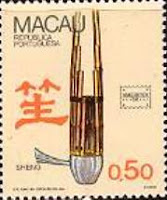Sheng on Stamps

The mouth organ Sheng was designed in China about 3000 years ago. The pipes are stopped with the fingers. When the piped are not stopped, the air causes the free metal reeds to vibrate. In more modern instruments, the reeds are made of brass and tuned with wax. The sheng's elegant shape reminds of the mythical phoenix. It consists of a mouthpiece, which may vary in shape, a wind-chest, and pipes.
In China, four of the seventeen pipes serve only as decoration; in Japan only two serve this purpose. In modern shengs, all pipes are functional, encompassing the chromatic octave a1-a2 and four higher diatonic notes. The sheng became popular in the 11th century B.C.. In Europe it attracted attention in the 18th century, when the free reed principle was used in a number of Western instruments, such as the harmonium and the accordion. In the East, the sheng is used as a solo instrument and in ensembles.
The stamp was issued by Macao in 1986






